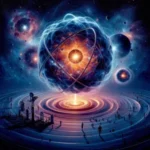The universe is a vast tapestry of wonders, and at its heart lie the majestic galaxies—dazzling collections of stars, gas, dust, and dark matter that tell the story of cosmic evolution.
From the spiraling arms of the Milky Way to the irregular shapes of dwarf galaxies, each type of galaxy boasts its own unique characteristics and mysteries waiting to be uncovered. As we delve into the depths of the cosmos, we invite you to embark on an enlightening journey through the diverse classifications of galaxies: spiral, elliptical, lenticular, and irregular. In this guide, we will explore their distinct formations and features, the role they play in the universe, and the fascinating phenomena that occur within them. Whether you’re an aspiring astronomer or simply curious about the wonders of the night sky, join us as we unlock the secrets of the galaxies and ignite your imagination with the beauty of the cosmos.
1. Introduction to Galaxies: What Are They?
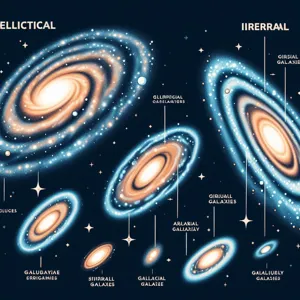
Galaxies are the towering beacons of the universe, vast collections of stars, gas, dust, and dark matter bound together by gravity. They are the building blocks of the cosmos, each hosting billions to trillions of stars, along with planets, moons, and other celestial bodies that orbit within their sprawling structures. The sheer scale of galaxies is awe-inspiring; they can range from a mere few thousand light-years across to over a hundred thousand light-years in diameter, encapsulating a treasure trove of astronomical wonders.
At their core, galaxies are not just random assemblages of stars; they are dynamic entities that evolve over billions of years. Their formation traces back to the early universe, when tiny fluctuations in density led to the gradual clumping of matter, giving rise to the first stars and, eventually, the galaxies we observe today. Each galaxy tells a unique story of cosmic evolution, influenced by factors like gravitational interactions, mergers with other galaxies, and the relentless processes of star formation and death.
In our universe, galaxies come in various shapes and sizes, categorized primarily into three main types: spiral, elliptical, and irregular. Spiral galaxies, like our very own Milky Way, feature beautiful, swirling arms filled with young, hot stars and vibrant nebulae. Elliptical galaxies, on the other hand, exhibit a more rounded appearance, often housing older stars and less interstellar gas, resulting in a more subdued glow. Irregular galaxies defy classification, with their chaotic structures resulting from gravitational interactions or collisions with neighboring galaxies.
Understanding galaxies is not only crucial for astronomers seeking to unravel the mysteries of the universe but also for anyone captivated by the night sky. Each galaxy holds clues to the origins of stars, the formation of solar systems, and the overall fate of the universe itself. As we embark on this exploration of the cosmos, we will delve deeper into the fascinating world of galaxies, uncovering their unique characteristics, formation processes, and the roles they play in the grand tapestry of existence.
2. The Structure of Galaxies: Components and Characteristics
The structure of galaxies is a fascinating topic that reveals the complexity and beauty of the universe. At their core, galaxies are vast collections of stars, gas, dust, and dark matter, held together by gravity. Understanding their components and characteristics not only enriches our knowledge of the cosmos but also highlights the unique features of different galaxy types.
**Stellar Population:** At the heart of every galaxy lies its stellar population, which can vary dramatically between different types of galaxies. Spiral galaxies, for example, are characterized by their well-defined arms winding out from a central bulge, where young, bright stars reside. These arms are rich in gas and dust, providing the ideal environment for star formation. In contrast, elliptical galaxies boast a more homogeneous stellar population, primarily composed of older, cooler stars, giving them a smoother, more featureless appearance.
**Galactic Nucleus:** The nucleus of a galaxy is another critical component, often housing a supermassive black hole at its center. This black hole can influence the motion of stars and gas in its vicinity. In many spiral galaxies, the nucleus is surrounded by a dense cluster of stars, while in elliptical galaxies, it may contain a more diffuse star distribution. Active galactic nuclei (AGN) are particularly interesting, as they emit immense amounts of radiation when matter falls into the supermassive black hole, illuminating the surrounding space.
**Dark Matter Halo:** Beyond the visible components lies the enigmatic dark matter halo, an invisible structure that envelops galaxies and plays a crucial role in their formation and evolution. Dark matter does not emit light, making it undetectable with conventional telescopes. However, its presence can be inferred through gravitational effects on visible matter. The distribution and density of dark matter halos can vary significantly between galaxy types, influencing their rotation curves and overall stability.
**Interstellar Medium:** The interstellar medium (ISM) is the matter that exists in the space between stars within a galaxy. Composed of gas, dust, and cosmic rays, the ISM is crucial for star formation and can be observed in various states—ranging from cold, dense clouds to hot ionized regions. Spiral galaxies typically exhibit a rich ISM, facilitating ongoing star formation, while elliptical galaxies may contain a more subdued ISM, resulting in reduced star production over time.
In summary, the structure of galaxies is a tapestry woven from stellar populations, galactic nuclei, dark matter halos, and the interstellar medium. Each component plays a vital role in defining the characteristics of different types of galaxies, from the dynamic, star-forming spirals to the more passive, aged ellipticals. As we continue to explore these magnificent structures, we deepen our understanding of the cosmos and our place within it.
3. The Three Main Types of Galaxies: An Overview
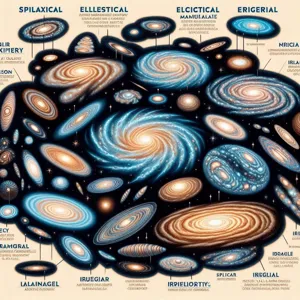
When we gaze into the night sky, the vast expanse filled with twinkling stars, we may not realize just how diverse the structures are that populate our universe. Galaxies, the colossal systems that house billions of stars, planets, and cosmic dust, can be classified into three main types: spiral, elliptical, and irregular. Each of these categories presents unique characteristics and fascinating features that contribute to our understanding of the cosmos.
**Spiral Galaxies** are perhaps the most visually striking, characterized by their flat, rotating disks with arms that spiral outward from the center. These arms are often home to young, hot stars that emit brilliant blue light, while the core typically harbors older, yellowish stars. The Milky Way, our own galaxy, is a prime example of a spiral galaxy. The intricate dance of stars within these spirals creates stunning patterns and a sense of dynamism, underscoring the active processes of star formation taking place in these regions.
**Elliptical Galaxies**, on the other hand, present a more subdued appearance. Ranging from nearly spherical to elongated shapes, these galaxies lack the distinct arms of their spiral counterparts. Elliptical galaxies are primarily composed of older stars, giving them a reddish hue. Their stellar populations are typically older and more uniform, with little to no new star formation occurring. The smooth, featureless appearance of elliptical galaxies stands in stark contrast to the vibrant structures of spiral galaxies, making them a fascinating subject of study for astronomers seeking to understand the evolution of stellar populations.
Lastly, **Irregular Galaxies** defy classification, exhibiting chaotic shapes and structures that lack the symmetry found in spiral and elliptical galaxies. These galaxies often arise from gravitational interactions and collisions with other galaxies, leading to their irregular forms. Rich in gas and dust, irregular galaxies are hotspots for new star formation, teeming with bright young stars. Their diversity and unpredictability make them a treasure trove for astronomers interested in the dynamic processes that shape galaxies over time.
Together, these three main types of galaxies illustrate the incredible variety of structures that populate our universe. Each type holds keys to understanding cosmic evolution, the lifecycle of stars, and the fundamental processes that govern the behavior of matter on a grand scale. As we explore the cosmos, we not only expand our knowledge of these celestial wonders but also our place within this vast and ever-changing universe.
4. Spiral Galaxies: Features and Examples
Spiral galaxies are among the most visually stunning and recognizable types of galaxies in the universe. Characterized by their distinct spiral arms that gracefully wind outward from a central bulge, these galaxies exhibit a beauty that captivates both amateur stargazers and seasoned astronomers alike. The arms of a spiral galaxy are often composed of bright, young stars, gas, and dust, creating a vibrant tapestry that can stretch across vast distances in space.
At the heart of many spiral galaxies lies a dense core, typically home to older stars and potentially a supermassive black hole. This core is surrounded by a rotating disk, where the spiral arms emerge. The dynamic nature of spiral galaxies is accentuated by their ongoing star formation, particularly in the arms, where the abundance of gas and dust fuels the birth of new stars. The contrast between the bright, blue stars in the spiral arms and the yellowish hues of older stars in the bulge adds to their striking appearance.
Some of the most famous examples of spiral galaxies include the Milky Way—our very own galactic home—and the Andromeda Galaxy, which is on a collision course with us, scheduled to merge in about 4.5 billion years. The Whirlpool Galaxy (M51) is another stunning spiral, renowned for its well-defined structure and interaction with a smaller galaxy, creating a captivating display of cosmic choreography.
In recent studies, spiral galaxies have been classified into two main categories: normal spirals and barred spirals. Normal spirals, like the Milky Way, exhibit distinct arms that extend from the galactic center. In contrast, barred spirals, such as the prominent NGC 1300, possess a central bar-shaped structure from which the spiral arms emanate. This variation adds another layer of complexity to the spiral galaxy classification, highlighting the diverse evolutionary paths these cosmic giants can take.
Spiral galaxies not only serve as a stunning visual spectacle but also play a crucial role in our understanding of the universe. Their structure and dynamics offer insights into star formation, galactic evolution, and the gravitational interactions that shape the cosmos. As we continue to explore and study these magnificent celestial bodies, we unveil the intricate workings of spiral galaxies and their place in the grand tapestry of the universe.
5. Elliptical Galaxies: Characteristics and Formation
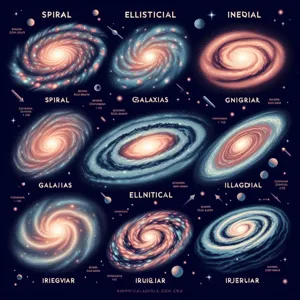
Elliptical galaxies, often characterized by their smooth, featureless light profiles, represent one of the most intriguing types of galaxies in the cosmos. Unlike their spiral counterparts, which boast vibrant arms of stars and gas, elliptical galaxies exhibit a more rounded, oval shape and display a range of sizes, from small dwarf ellipticals to massive giants that contain trillions of stars. Their stellar populations tend to be older, with a predominance of red stars, which gives them a warm, yellowish hue when observed through telescopes.
The formation of elliptical galaxies is still a subject of extensive research, but scientists believe that they primarily arise through the merging of smaller galaxies. When two galaxies collide, their gravitational forces can disrupt their structures, leading to a chaotic amalgamation of stars and gas. Over time, this interaction results in a more uniform distribution of stars and an overall elliptical shape. This process, known as galactic merger, is a fundamental aspect of galaxy evolution and highlights the dynamic nature of the universe.
Additionally, elliptical galaxies often lack the significant amounts of gas and dust found in spiral galaxies, making star formation relatively rare in these environments. This scarcity of interstellar material contributes to their older stellar populations, as new stars have fewer opportunities to form. The absence of gas can also indicate that these galaxies have consumed most of their available materials through past star formation or interactions with neighboring galaxies.
Elliptical galaxies can vary hugely in size and mass, with some residing at the centers of galaxy clusters as colossal giants, while others are smaller satellites orbiting larger galaxies. The interplay of gravity, dark matter, and cosmic evolution continues to shape our understanding of these fascinating structures, revealing the complex tapestry of the universe. As we explore the cosmos further, elliptical galaxies stand out as vital pieces of the puzzle, offering insights into the life cycles of galaxies and the forces that govern their evolution.
6. Irregular Galaxies: Exploring Their Unique Structure
Irregular galaxies are the cosmic rebels of the universe, defying the conventional shapes and structures that characterize their more orderly counterparts. Unlike spiral and elliptical galaxies, which exhibit clear forms and patterns, irregular galaxies present a delightful chaos that captivates astronomers and skywatchers alike. Their unique structure is often a reflection of a tumultuous past, marked by gravitational interactions, collisions, and merging events with other galaxies.
One of the most fascinating aspects of irregular galaxies is their asymmetrical appearance. They lack the defined arms of spiral galaxies and the smooth, rounded profiles of elliptical ones, instead boasting a patchwork of star clusters, gas clouds, and dust. Prominent examples include the Large and Small Magellanic Clouds, which dance around our Milky Way, showcasing a blend of bright stars and darker regions that hint at ongoing star formation. These galaxies often harbor a rich tapestry of elements, providing scientists with invaluable insights into the life cycles of stars and the evolution of cosmic structures.
The irregular shape of these galaxies is not just for show; it plays a critical role in their development. The chaotic nature of their structure often allows for high rates of star formation, as dense regions of gas and dust collapse under their own gravity. This leads to vibrant bursts of starlight that can illuminate the surrounding darkness, making irregular galaxies some of the most interesting subjects in astrophysical research.
In exploring irregular galaxies, we delve into the mysteries of the universe, where each one tells a story of its history, interactions, and unique characteristics. These celestial wonders remind us that in the vast expanse of the cosmos, beauty often lies in the unexpected, inviting us to ponder the dynamic and ever-changing nature of the universe we inhabit.
7. Dwarf Galaxies: The Small Giants of the Cosmos
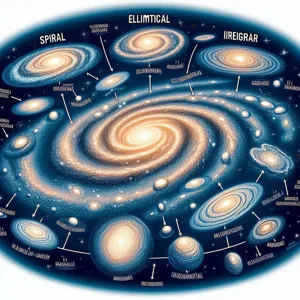
Dwarf galaxies, often overshadowed by their larger counterparts, are fascinating celestial entities that challenge our understanding of the universe’s structure. Despite their diminutive size—typically containing just a few billion stars compared to the hundreds of billions found in larger galaxies—these small giants play a significant role in the cosmic landscape.
Dwarf galaxies come in various flavors, including dwarf elliptical, dwarf spiral, and dwarf irregular, each exhibiting unique characteristics that reflect their formation and evolution. Dwarf elliptical galaxies, for instance, are smooth and featureless, lacking the distinct structure seen in larger elliptical galaxies. They often reside in groups or clusters, quietly orbiting their more massive neighbors. On the other hand, dwarf irregular galaxies are chaotic in appearance, with a patchwork of stars, gas, and dust, often giving them a vibrant, youthful look.
One of the most intriguing aspects of dwarf galaxies is their relationship with dark matter. Many of these galaxies appear to contain a substantial amount of dark matter, more than their visible mass would suggest. This has led astronomers to propose that dwarf galaxies could be key players in understanding dark matter’s role in the universe’s formation and evolution.
Noteworthy examples include the Magellanic Clouds, two irregular dwarf galaxies that orbit our Milky Way and are visible from the Southern Hemisphere. These galaxies are not only beautiful to behold but also serve as laboratories for studying stellar formation and the effects of gravitational interactions.
Despite their size, dwarf galaxies are abundant throughout the cosmos. In fact, they are believed to outnumber the larger galaxies by a significant margin. This prevalence invites researchers to explore how these small giants influence galactic evolution and the large-scale structure of the universe. As we continue to study dwarf galaxies, our understanding of their complex dynamics, formation histories, and their contributions to the cosmic tapestry will undoubtedly deepen, revealing more about the universe we inhabit.
8. The Role of Dark Matter in Galaxy Formation
Dark matter is one of the universe’s most enigmatic and fascinating components, playing a crucial role in the formation and evolution of galaxies. Unlike ordinary matter, which makes up stars, planets, and all visible structures in the universe, dark matter cannot be seen or directly detected. Instead, its presence is inferred through its gravitational influence on visible matter. This mysterious substance is estimated to constitute about 27% of the universe, overshadowing the mere 5% that is made up of the atoms that form everything we can observe.
In the early universe, shortly after the Big bang, tiny fluctuations in density created regions where dark matter began to clump together. These clumps acted like scaffolding, providing the gravitational framework within which ordinary matter could gather and form galaxies. As gas and dust fell into these dark matter halos, they compressed and heated, eventually igniting nuclear fusion to create stars and galaxies. Without the presence of dark matter, the universe as we know it would be drastically different, as many galaxies would not have formed at all or would be significantly smaller.
The distribution of dark matter also influences the structure and behavior of galaxies. For instance, spiral galaxies like our Milky Way possess a substantial halo of dark matter, extending far beyond the visible components. This halo helps maintain the rotation speeds of stars within the galaxy, preventing them from flying apart. Meanwhile, in elliptical galaxies, the role of dark matter is similarly pivotal, contributing to their more uniform distribution of stars.
Recent advancements in technology and observational techniques have allowed astronomers to map dark matter’s influence more accurately, revealing a complex web of dark matter structures throughout the cosmos. As we continue to explore the universe, understanding the role of dark matter in galaxy formation not only deepens our knowledge of galactic structures but also unlocks insights into the fundamental workings of the universe itself. Ultimately, dark matter remains one of the greatest puzzles in modern astrophysics, inviting us to explore further and understand what lies beyond the observable universe.
9. Galaxy Clusters and Superclusters: A Cosmic Community
As we delve deeper into the vast expanse of the universe, we uncover not just individual galaxies, but also the intricate networks that connect them: galaxy clusters and superclusters. These colossal groupings showcase the grandeur of cosmic structures, where galaxies gather in a gravitational dance, united by the invisible threads of dark matter.
Galaxy clusters, typically containing anywhere from a few dozen to several thousand galaxies, form the fundamental building blocks of the universe. Within these clusters, galaxies interact, collide, and merge, creating spectacular cosmic drama. The gravitational forces at play not only influence the motion of the galaxies but also affect the dynamics of the hot gas that fills the space between them. This gas, often reaching millions of degrees, can be observed in X-ray wavelengths, revealing the energetic processes occurring in these crowded environments.
Zooming out even further, we encounter superclusters—massive formations that contain multiple galaxy clusters bound together in a web of cosmic filaments. The Local Group, which includes our Milky Way, is part of the Virgo Supercluster, an expansive region that encompasses thousands of galaxies and stretches over hundreds of millions of light-years. Superclusters are the largest known structures in the universe and highlight the vastness and complexity of cosmic organization.
These cosmic communities are not just fascinating for their sheer size; they also hold clues to understanding the evolution of the universe. By studying the distribution and behavior of galaxies within clusters and superclusters, astronomers can glean insights into dark matter, dark energy, and the forces that have shaped our cosmos since its inception. As we continue to explore these galactic neighborhoods, we uncover the interconnectedness of the universe, reminding us that even in the vast emptiness of space, we are all part of a larger, breathtaking tapestry.
10. The Life Cycle of Galaxies: Formation to Evolution
The life cycle of galaxies is a fascinating journey that unfolds over billions of years, beginning with the primordial gas clouds left over from the Big Bang. This cosmic ballet starts with the formation of stars within these clouds, where regions of denser gas collapse under their own gravity, igniting nuclear fusion and giving birth to new stars. These stars, in turn, cluster together, eventually forming the first galaxies.
As galaxies evolve, they go through various stages influenced by their environment and interactions with neighboring galaxies. Some galaxies, like spiral galaxies, maintain a structured form characterized by distinct arms spiraling out from a central bulge. These arms are teeming with young, hot stars and nebulae, where new stars are continuously being born. On the other hand, elliptical galaxies present a different picture—smoother and more rounded, they consist primarily of older stars, with little ongoing star formation.
As galaxies continue to evolve, they can undergo significant transformations through collisions and mergers. When two galaxies collide, their gravitational forces can reshape their structures, often leading to bursts of star formation as gas clouds collide and compress. This cataclysmic event may result in the creation of new galaxy types, such as irregular galaxies, which lack the defined shapes of their spiral and elliptical counterparts.
Over time, galaxies can also experience a gradual decline in star formation, leading to what astronomers call “passive evolution.” This phase is marked by the depletion of gas and dust, the primary ingredients for star formation, resulting in a redder appearance as older stars dominate the stellar population.
The life cycle of galaxies is an intricate and ongoing process, rich with the interplay of cosmic forces and events. By studying the formation and evolution of galaxies, astronomers not only learn about the history of the universe but also gain insight into the future of our own Milky Way. As we gaze into the cosmos, we witness the dynamic life cycles of galaxies, each telling a unique story of creation, transformation, and enduring existence.
11. The Importance of Studying Galaxies in Cosmology
Studying galaxies is fundamental to our understanding of the universe and our place within it. These vast collections of stars, gas, dust, and dark matter serve as the building blocks of the cosmos, offering profound insights into the origins and evolution of the universe itself. In cosmology, galaxies are not merely objects of fascination; they are key indicators of the underlying physics that govern the cosmos.
First and foremost, galaxies help us trace the history of the universe from the Big Bang to the present day. By observing the light emitted from different galaxies, astronomers can determine their ages, compositions, and distances. This information allows scientists to construct a timeline of cosmic history and understand the formation and evolution of structures in the universe. For instance, studying distant galaxies reveals how they have changed over billions of years, offering clues about the processes that drive star formation and galactic interactions.
Moreover, galaxies act as natural laboratories for testing theories of gravity, dark matter, and dark energy. The dynamics of galaxy formation and their gravitational interactions provide valuable information about the distribution of dark matter, which is thought to make up approximately 27% of the universe’s mass. By analyzing the rotation curves of spiral galaxies or the gravitational lensing effects observed in clusters, researchers can infer the presence and behavior of dark matter, enhancing our understanding of this elusive component of the universe.
Galaxies also play a crucial role in the ongoing quest to comprehend the expansion of the universe. The discovery of the accelerating expansion, attributed to dark energy, was largely informed by observations of distant galaxies. By studying supernovae and the cosmic microwave background radiation, cosmologists can refine their models of the universe’s fate and its ultimate destiny.
In summary, the study of galaxies is not only about understanding these magnificent structures but also about unraveling the mysteries of the universe itself. As we continue to explore the cosmos, each galaxy we observe offers a unique story that contributes to the grand narrative of our universe, deepening our appreciation for the vastness of space and the intricate web of cosmic connections.
12. Methods of Observing and Classifying Galaxies
Understanding the vastness of the cosmos and the myriad of galaxies within it requires not only sophisticated technology but also a systematic approach to observation and classification. Astronomers employ a variety of methods to study galaxies, each revealing different facets of these majestic cosmic structures.
One of the primary techniques for observing galaxies is through photometry, which measures the intensity of light emitted by celestial bodies. By analyzing the light from a galaxy, astronomers can determine its brightness, color, and distance. This information is crucial for understanding a galaxy’s composition, age, and the processes occurring within it. For instance, the colors observed can hint at the presence of young, hot stars or older, cooler stars, providing insights into the galaxy’s evolutionary history.
Spectroscopy is another pivotal method, allowing scientists to dissect the light from galaxies into its constituent colors. This technique reveals essential details about the galaxy’s chemical composition, temperature, and motion. By studying the spectral lines, astronomers can identify the elements present and gauge whether a galaxy is moving toward or away from us, a concept known as redshift and blueshift, respectively. This movement also aids in estimating the galaxy’s distance and speed, crucial for understanding the expansion of the universe.
Modern telescopes, equipped with advanced imaging technology, enable astronomers to capture stunning images of galaxies across different wavelengths of light—from radio waves to infrared to X-rays. These multi-wavelength observations are essential for a comprehensive understanding of galaxies, as different wavelengths can reveal unique features and phenomena. For example, radio telescopes can uncover cold gas clouds, while X-ray observations can highlight regions of high-energy activity, such as black holes and neutron stars.
Classification of galaxies is primarily done using the Hubble Sequence, which categorizes galaxies into three main types: spiral, elliptical, and irregular. Spiral galaxies, with their characteristic arms winding outwards from a central bulge, are often rich in gas and dust, making them sites of active star formation. Elliptical galaxies, in contrast, are more uniform and lack the intricate structure of spirals, often containing older stars and minimal gas. Irregular galaxies defy classification, showcasing chaotic structures and a mix of star formation activity.
Additionally, advances in machine learning and artificial intelligence have started to play a significant role in galaxy classification. By training algorithms on vast datasets, astronomers can automate the identification process, quickly sorting through millions of galaxy images to pinpoint specific types and characteristics.
In summary, the methods of observing and classifying galaxies are as diverse as the galaxies themselves. Through a combination of light analysis, advanced imaging, and innovative technology, astronomers continue to enhance our understanding of these extraordinary cosmic entities, unlocking secrets about the universe’s past, present, and future.
13. Notable Galaxies in the Universe: A Closer Look
When we gaze into the vastness of the night sky, we are often struck by the sheer beauty and complexity of the cosmos. Among the countless celestial bodies, galaxies stand out as magnificent islands of stars, gas, and dust, each with its own unique character and story. In this section, we will take a closer look at some of the most notable galaxies that populate our universe, illuminating their distinctive features and the mysteries that surround them.
**1. The Milky Way Galaxy:** Our very own galaxy, the Milky Way is a barred spiral galaxy that houses our solar system. Its structure is composed of a central bulge surrounded by a flat, rotating disk of stars, gas, and dust, with spiral arms winding outwards. Home to an estimated 100 to 400 billion stars, the Milky Way is a bustling metropolis of stellar activity. Its awe-inspiring beauty can be appreciated through stunning images captured by space telescopes, revealing the intricate dance of stars and nebulae that define our galactic home.
**2. Andromeda Galaxy (M31):** The closest spiral galaxy to the Milky Way, Andromeda is on a collision course with our galaxy, set to merge in about 4.5 billion years. Stretching over 220,000 light-years across, it is estimated to contain one trillion stars. Andromeda is often referred to as M31 in catalogues, and it has been a subject of fascination for astronomers and stargazers alike due to its impressive size and proximity. With its bright core and prominent spiral arms, it is a favorite target for astrophotographers capturing the night sky.
**3. Whirlpool Galaxy (M51):** Known for its stunning spiral structure, the Whirlpool Galaxy is a classic example of a grand design spiral galaxy. Located about 23 million light-years away, its sweeping arms are home to numerous young, hot stars, giving it a vibrant blue hue. The interaction with a smaller galaxy nearby, NGC 5195, contributes to its distinct appearance, creating a dynamic cosmic ballet that has captivated astronomers since its discovery.
**4. Sombrero Galaxy (M104):** With its bright nucleus and dust lanes resembling the brim of a hat, the Sombrero Galaxy stands out as one of the most striking galaxies in the night sky. Located roughly 29 million light-years away, this spiral galaxy is notable for its large central bulge and prominent dust ring. The Sombrero Galaxy’s unique profile has made it a popular subject for both amateur and professional astronomers, and it serves as a reminder of the diversity of galactic structures that exist in the universe.
**5. The Triangulum Galaxy (M33):** As the third-largest member of our Local Group of galaxies, the Triangulum Galaxy is a beautiful example of a spiral galaxy. Located about 3 million light-years from Earth, it is less massive than the Milky Way but contains a wealth of stars and nebulae. The Triangulum Galaxy is often considered a stepping stone for those exploring the universe due to its relative proximity and the opportunity it offers for studying stellar formation and galactic evolution.
These notable galaxies, each with its own story, contribute to the rich tapestry of the universe. As we continue to explore the cosmos, our understanding of these galactic giants deepens, revealing the intricate processes that govern their formation, evolution, and interaction. Whether through telescopic observation or theoretical research
14. The Future of Galaxy Exploration: Upcoming Missions and Technologies
As we stand on the brink of a new era in astronomy, the future of galaxy exploration promises to be as thrilling as the cosmos itself. With advancements in technology and a renewed interest in understanding our universe, several upcoming missions aim to unlock the secrets of galaxies far beyond our own.
One of the most anticipated missions is NASA’s James Webb Space Telescope (JWST), scheduled for launch in the near future. This powerful observatory is designed to peer deeper into the universe than ever before, allowing scientists to study the formation and evolution of galaxies. With its advanced infrared capabilities, JWST will enable astronomers to observe the faint light of distant galaxies, shedding light on their composition, structure, and the mysterious dark matter that influences their behavior.
Another exciting development is the European Space Agency’s Euclid mission, which aims to map the geometry of the dark universe. By surveying billions of galaxies, Euclid will help researchers understand the role of dark energy in the expansion of the universe and how it affects galaxy formation. The mission promises to provide detailed insights into the distribution of dark matter and how galaxies interact within the cosmic web.
Moreover, advancements in ground-based observatories, such as the Extremely Large Telescope (ELT) being constructed in Chile, are set to revolutionize our understanding of galaxies. With its unprecedented size and cutting-edge technology, the ELT will capture images of galaxies with remarkable clarity, enabling scientists to study their star formation processes and the environments surrounding supermassive black holes.
As we venture further into the cosmos, citizen science initiatives are also gaining momentum. Projects that engage the public in galaxy classification and data analysis allow amateur astronomers to contribute to significant discoveries and foster a sense of community around galaxy exploration.
These upcoming missions and technologies not only enhance our understanding of galaxies but also inspire a new generation of astronomers and space enthusiasts. With each leap forward, we draw closer to unraveling the mysteries of the universe, igniting our curiosity and expanding our knowledge of the majestic galaxies that populate the cosmos. The future of galaxy exploration is bright, and the possibilities are as limitless as the stars themselves.
15. Conclusion: The Significance of Galaxies in Our Understanding of the Universe
In conclusion, galaxies are not merely vast collections of stars, gas, and dust; they are the very building blocks of our universe, offering profound insights into its origins, structure, and evolution. Each galaxy, with its unique characteristics and complexities, tells a story about the cosmic tapestry that encompasses all existence.
The study of galaxies allows astronomers to unlock the secrets of dark matter, decipher the mechanisms behind star formation, and trace the evolution of the cosmos from the Big Bang to the present day. By observing different types of galaxies—spiral, elliptical, and irregular—scientists can piece together the history of our universe, gaining valuable knowledge about how galaxies interact, merge, and evolve over billions of years.
Moreover, galaxies serve as laboratories for understanding fundamental astrophysical processes. They provide a framework for exploring the relationships between mass, light, and gravity, shedding light on the forces that govern celestial behavior. As we continue to explore the depths of space, the insights gained from studying galaxies will not only enhance our scientific knowledge but also deepen our appreciation for the intricate and beautiful universe we inhabit.
As we gaze into the night sky, let us remember that each twinkling star is part of a magnificent galaxy, a testament to the vastness of the cosmos and our place within it. Embracing the significance of galaxies in our understanding of the universe invites us to ponder our origins and inspires future generations to reach for the stars. In the grand cosmic dance, the exploration of galaxies remains a vital and exciting frontier, beckoning us to unravel the mysteries that lie beyond our own pale blue dot.
As we conclude our journey through the cosmos and explore the mesmerizing diversity of galaxies, we hope you’ve gained a deeper appreciation for the vastness and complexity of our universe. From the majestic spirals of the Milky Way to the enigmatic beauty of elliptical and irregular galaxies, each type offers a unique glimpse into the cosmic tapestry that surrounds us. Understanding these celestial structures not only enriches our knowledge of astronomical phenomena but also ignites a sense of wonder and curiosity about our place in the universe. So, whether you’re an aspiring astronomer or simply a starry-eyed dreamer, we encourage you to keep looking up and exploring the infinite possibilities that await among the stars. Happy stargazing!






